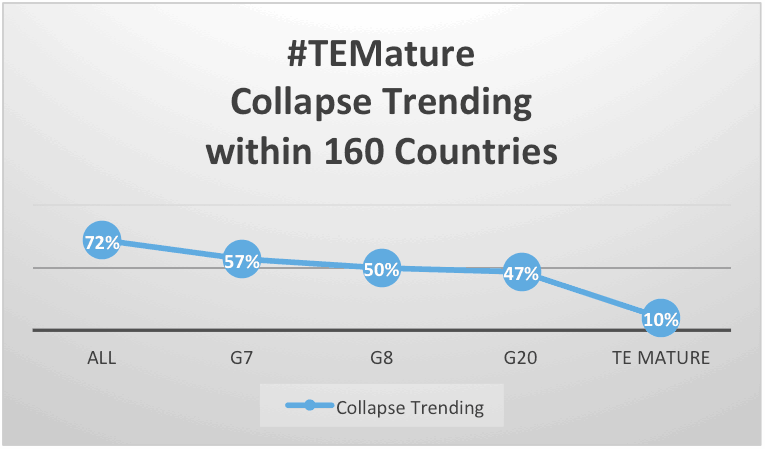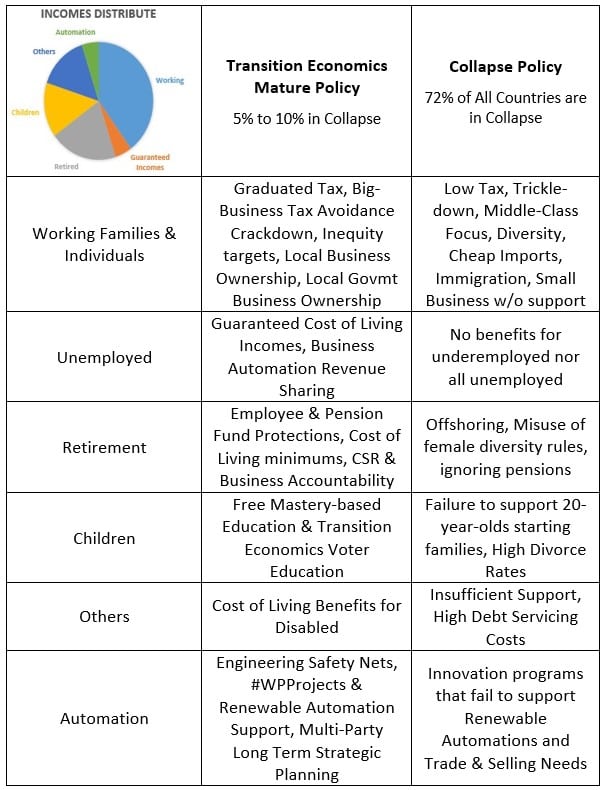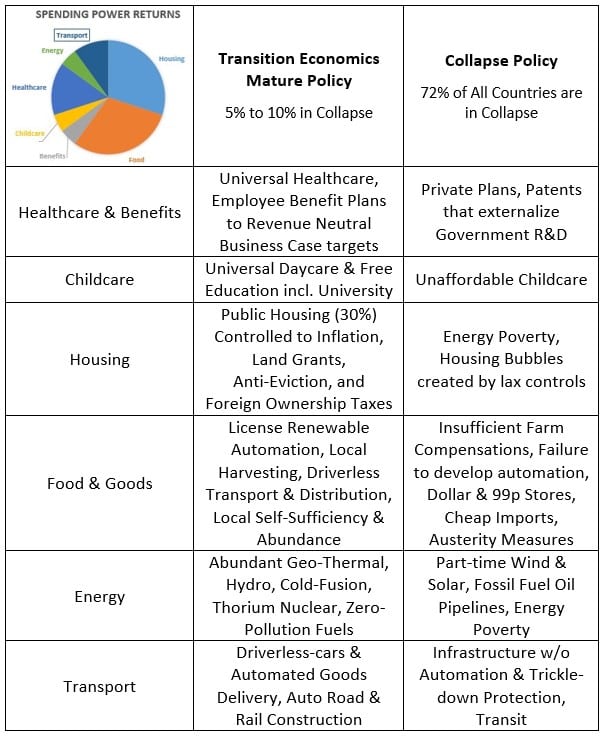Tagged: democracy, government policy, policy, politics, society, sustainability
- This topic has 0 replies, 1 voice, and was last updated 7 years, 3 months ago by
etilley.
-
AuthorPosts
-
January 20, 2017 at 2:47 am #5696
etilley
Keymaster

Right or Left of What? Democracy’s Loss of Good Planning
Conservatism and Liberalism are over-used terms that have come to discourage critical thinking for decades now. Since the McCarthy Era of the early 1950s, Right and Left have quickly come to encourage right and wrong, good or bad over-simplifications called “Absolutes”.
I like to think of Absolutes as the favourite first and last resort of a lazy mind – as they only very rarely can describe solutions for complex economies and they infrequently summarize critical-thought and unemotional reasoning. Absolutes attempt to simplify a message, but often they simply ask the listener to over-look logic gaps. At the point that too many discussions overwhelm a listener, the mind dizzies until all that remains is a sense of frustration for having only a human capacity to analyse many complex discussions.
It is normal to want to understand something as important as our economy and our children’s future – and so we “boil it down” – even when we should not try to oversimplify.
How big are the real solutions? Well, to give you an idea of the size, it has taken me 600 pages and a book
 to fully explain all of the supporting research needed to make responsible government policy in any society. One book detailed how to step-by-step build a sustainable Good Life and World Peace for us all – 500 pages
to fully explain all of the supporting research needed to make responsible government policy in any society. One book detailed how to step-by-step build a sustainable Good Life and World Peace for us all – 500 pages  ; two books summarized the policies and democratic voting processes needed to sustain and reset successful Capitalist economies – 300 pages
; two books summarized the policies and democratic voting processes needed to sustain and reset successful Capitalist economies – 300 pages  and 500 pages
and 500 pages  . A course that explained to high-schoolers how to make common sense decisions more consistently took 400 pages
. A course that explained to high-schoolers how to make common sense decisions more consistently took 400 pages  .
.We can reduce and simplify well researched lessons-learned into high-level bullets and charts, but in a democratic society we must also invest a little time to understand the well-researched details that support a credible summary.
It is worth taking the time to learn which Policies have been proven to sustain an economy and society. Why? Because since learning this myself, I have no questions of what our countries must do next – globally. I can also sleep at night realizing that my vote will not make matters worse for my family and their children. I do not fear nuclear devastation nor do I believe it inevitable – and I realize that the world can look forward to a tremendous future once enough of us understand these lessons too.
To understand how the very common mistake of endorsing Absolutes for what is “Conservative”, and what is “Liberal” in most of the G7 countries, we have to go back in time and recall a few lessons from history.
The terms Right and Left, Conservative and Liberal, were originally used to describe groups that sat on either side of the King. Each side – right and left – were tasked with approaching to task of solid country planning from either a more risky or more safe, pragmatic implementation point-of-view.
Although you might argue the minutia of my definition, what is absolutely true is that neither Conservatives nor Liberals were ever supposed to knowingly endorse irresponsible policy. The King would have been trained in the proper running of a country since boyhood and his legislature would simply be asked to take different tacts on his prudent, informed direction. The King would have had help establishing his planning for the nation of course; historians, economists, educators, engineers, and financial subject matter experts would collaborate on long-term planning for the country.
 In a democracy, there are no monarchs to do this for us. We have to insist this is done for us by our elected representatives and we have to train our children to understand how to vote for policies that sustain their economies and Good Lives too.
In a democracy, there are no monarchs to do this for us. We have to insist this is done for us by our elected representatives and we have to train our children to understand how to vote for policies that sustain their economies and Good Lives too.So you see, the absence of a ratified long-term plan for any country, means that its policies can neither be Right nor Left. Without a plan, how can they be Left or Right of something that has not been defined?
 Long term planning has fallen away from G7 Countries for decades now; a casualty of short-term 4-year election cycles that promised citizens what they might like to hear – instead of what is needed for the success of the country and its economy.
Long term planning has fallen away from G7 Countries for decades now; a casualty of short-term 4-year election cycles that promised citizens what they might like to hear – instead of what is needed for the success of the country and its economy.This might explain why 72% of the 180 countries researched in Transition Economics Maturity Modeling are in a Collapse Trending today.
Lets consider an example Policy: Anyone who might believe that Low-Tax is a Conservative Policy – is misunderstanding the meaning of what is Conservatism.
A thinking person – one who does their research – can easily confirm that Low-Tax of the sort that we called Reaganism and Thatcherism in the 1980s (also called trickle-down economics), leads to inequity, hoarding, recession, depression, and eventually revolutions and wars too. Low-Tax is a short-term, short-sighted, unsustainable policy only; and recall that Conservatives were never intended to represent unworkable policy.
In fact, a Conservative imperative of pragmatism should say No to Low-Tax policy outright based on historical evidence and based on its empirically validatible poor track record. Trying to run a short-term-only strategy like Low-Tax would more likely be adopted by a Liberal Left in fact, because this policy adds risk to an economy by opening it up to social and productivity problems created by inequity.
Productivity problems? Yes of course. How can an individual contribute to the economy with their spending or businesses, if they do not have the basic incomes needed to participate? They cannot.
In the U.S., 160 million people (40% – according to the 2010 U.S. Fed Reserve Budget Report) are too poor to help lift the economy nor even participate. Look up annual per-capita-export online to see this Opportunity Cost for your country. If American’s had the same opportunities that Dutch Citizens had, they would contribute much more than their current $5000 each to their country’s wealth creation efforts; instead they would earn $33,000 each.
This additional $28,000 per citizen would add $8 trillion to the U.S.’s exports; $600 billion would be added to Canada’s exports; $1.5 trillion to U.K. citizens – Annually!
Such are the Opportunity Costs created by Inequity – and we can now calculate that these new incomes would easily pay for the healthcare, childcare, guaranteed incomes, and other social support policy and programs required to support everyone. I completed this math for several countries in my book Transition Economics and you can see it here online in my article “The Business Case for Empathy“.
So what are Economic Development Plans and what do they look like? Aristotle called these “Right Plans” by the way – and Yes – this exact form of planning and economic controls have been around since first recorded on the Code of Hammurabi in 1760 BCE – 4000 years ago; since shortly after civilizations began in our recorded history. This fact should not surprise a single one of us.
First, Right Plans have many components and many policies; there really is no One-important-thing. Instead, there are many important Policies that must ensure that everyone has an Income and that those incomes maintain sufficient Spending Power to afford a Good Life.
Second, Right Plans have to take into account the natural sixty-year cycles of capitalist societies – cycles called Longwaves or K-Waves by Cycle Economists. Inequity is low at the start of a new economic cycle, as it was in the 1950s, and then inequity slowly grows throughout the cycle until it is high again – like it is today. The code of Hammurabi enacted Jubilees – country-wide wealth redistribution – every 50-years as a pre-emptive economic control that averted depressions and revolutions. Once economies were reset, another sixty year cycle of prosperity could begin.
Third, there is little guess-work needed in long-term planning. #TEMature Policy are an example of a researched list of policies that are proven to create collapse trendings in just 5% of countries where utilized – as compared to 72% of all other countries today. The research is imperial; it is provable easily in nature – which means that it is scientific too. This thinking – forms the supports needed for good decision making; thinking that is pragmatic and considered – and it serves to support beneficial solutions and planning.
The next time some-one asks you “What would a Conservative do?” or “What would a Liberal do”, the right answer should always be the same – “Sustainable Policy” – and this is the policy that best supports the country’s long-term Vision, Plan, and Values”.
—
The following charts are borrowed from #TEMature Policy on our Transition Economics Maturity Modeling page. These are explained in the new book Transition Economics.
Read more about Transition Economics, Automation, and the creation of effective Government Policy here…



-
AuthorPosts
- You must be logged in to reply to this topic.


